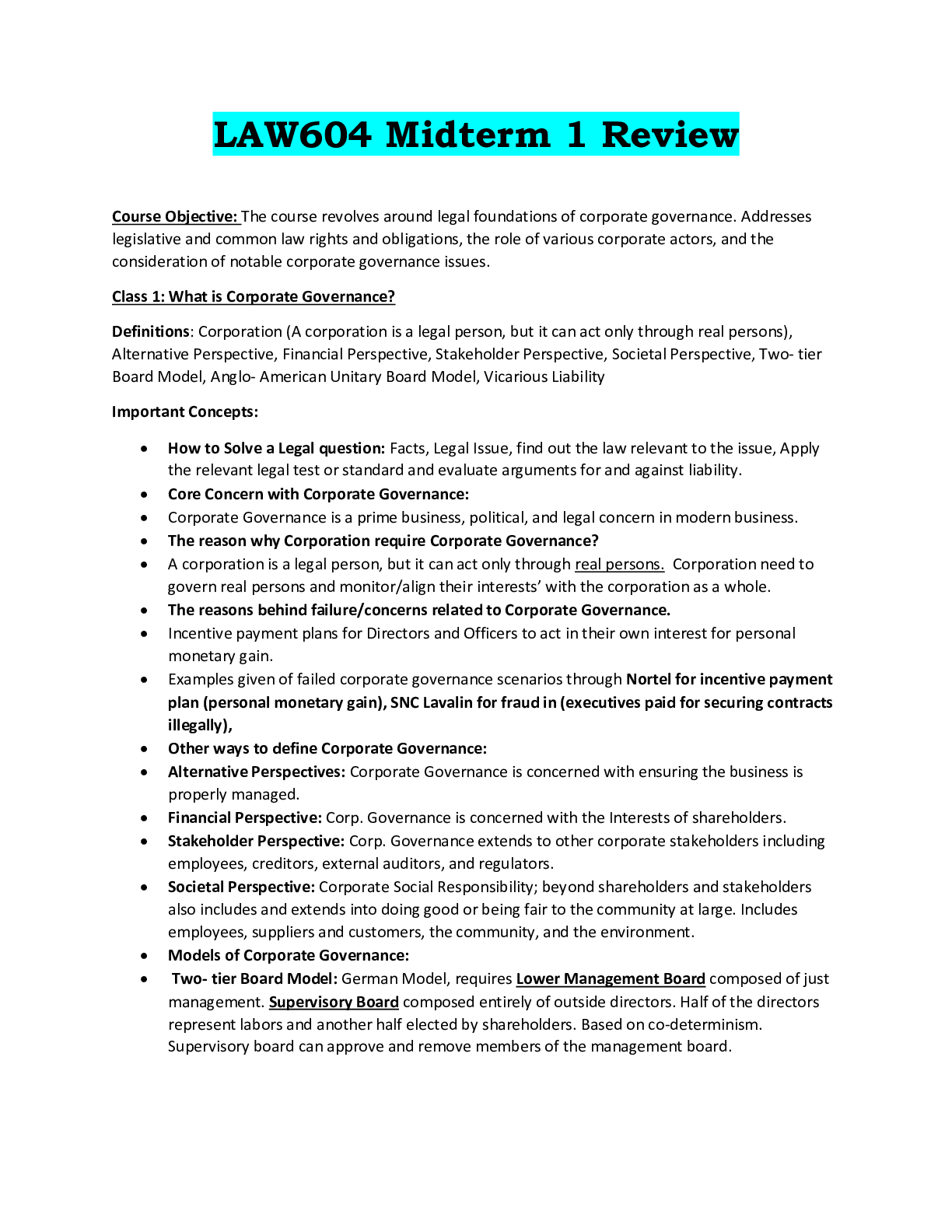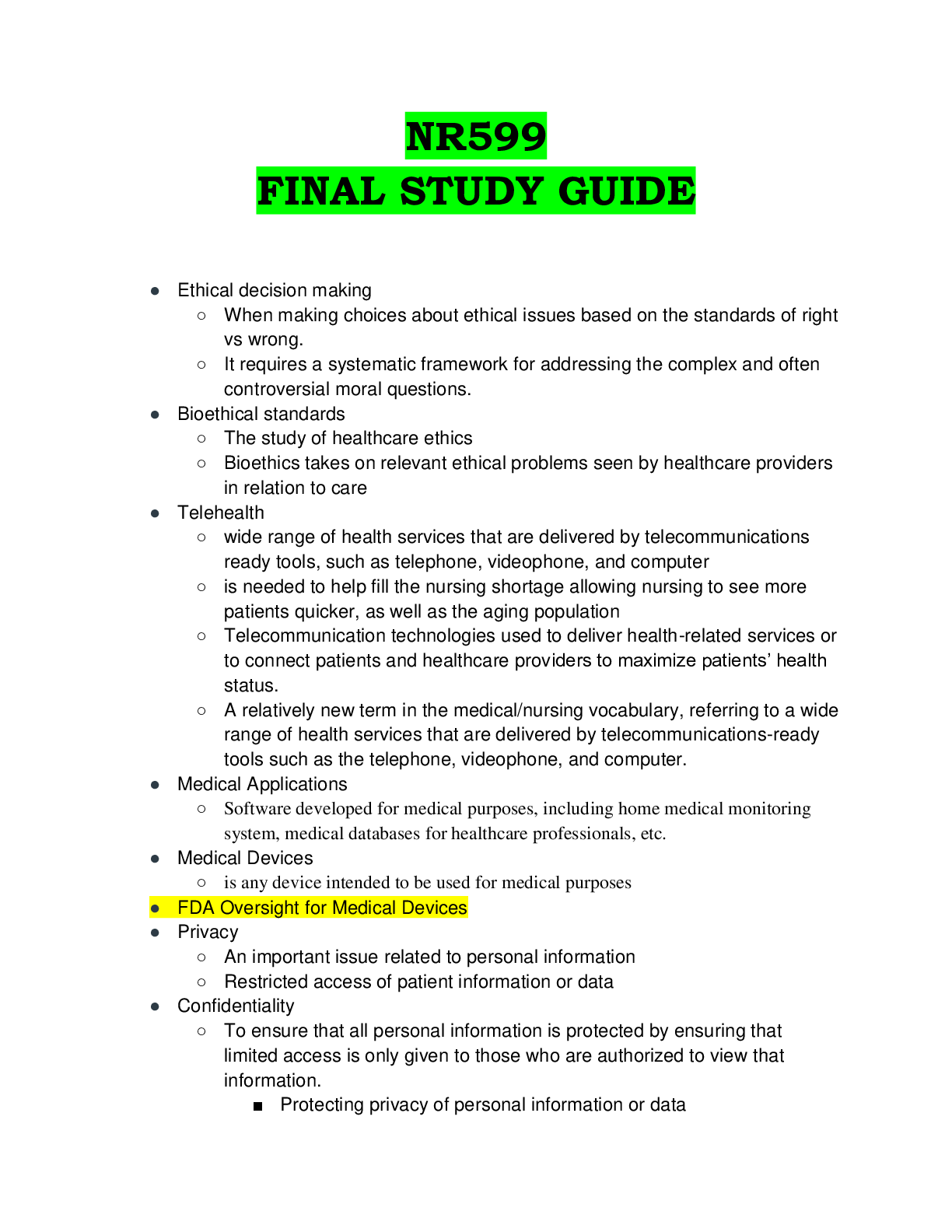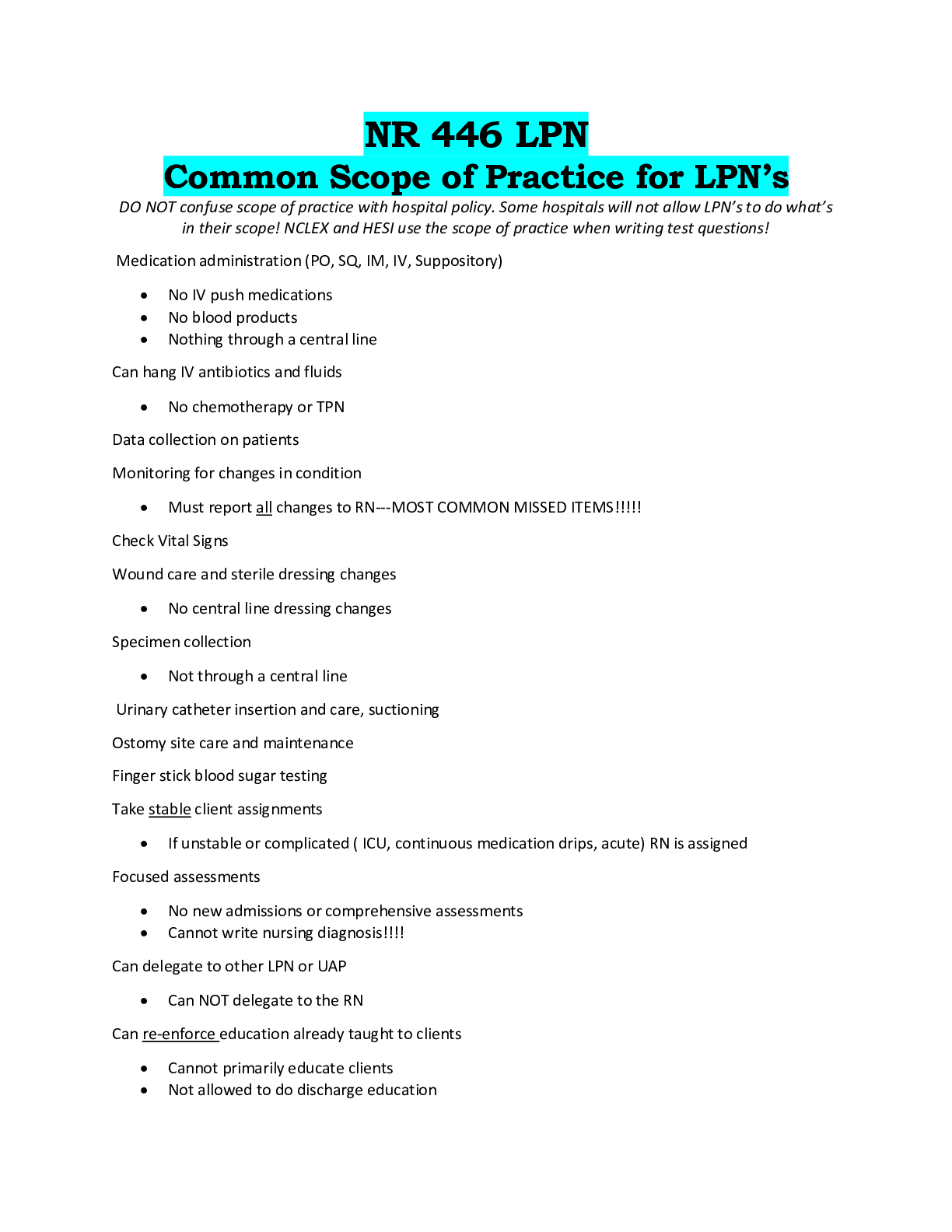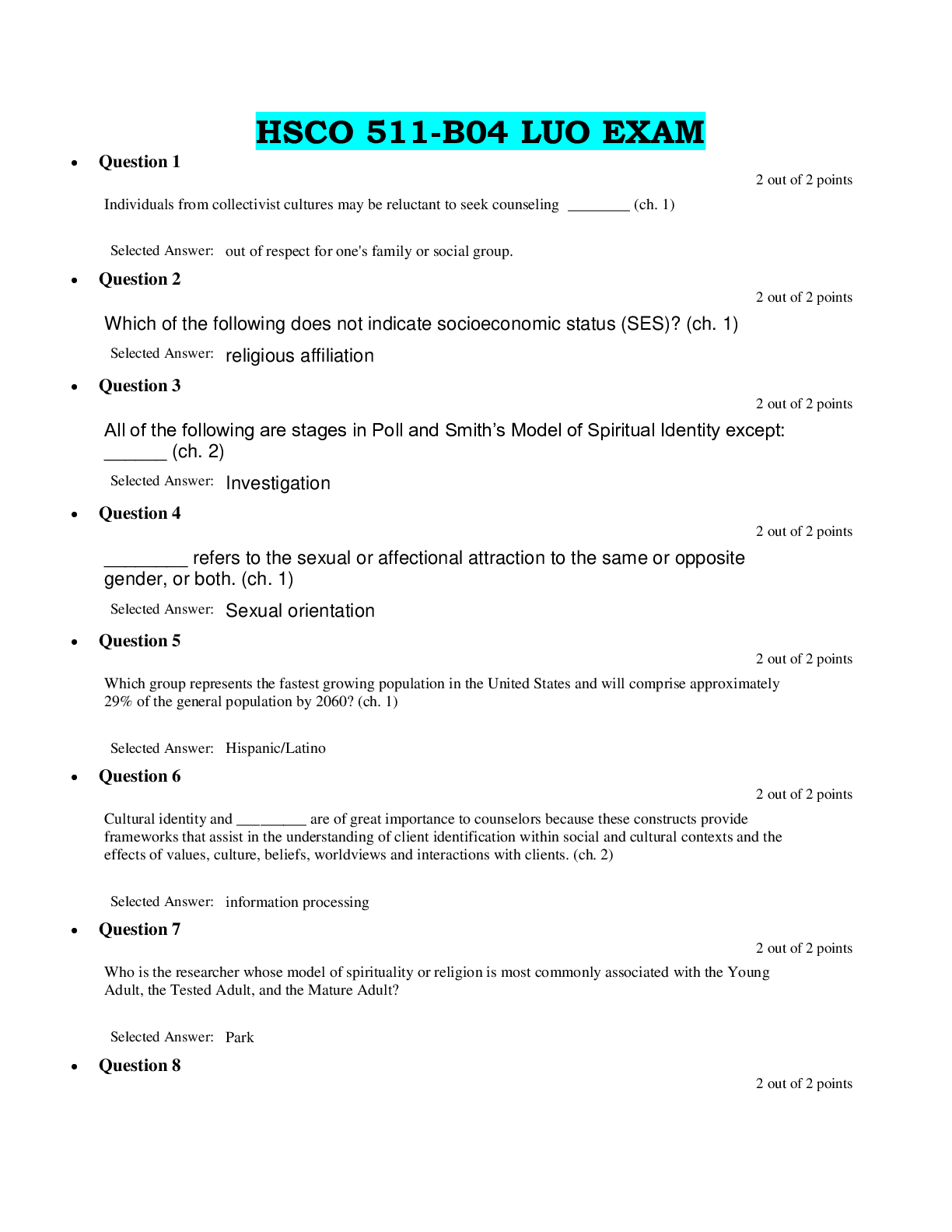Law > EXAM REVIEW > LAW604 Midterm 1 Review (All)
LAW604 Midterm 1 Review
Document Content and Description Below
LAW604 Midterm 1 Review Course Objective: The course revolves around legal foundations of corporate governance. Addresses legislative and common law rights and obligations, the role of various corpo... rate actors, and the consideration of notable corporate governance issues. Class 1: What is Corporate Governance? Definitions: Corporation (A corporation is a legal person, but it can act only through real persons), Alternative Perspective, Financial Perspective, Stakeholder Perspective, Societal Perspective, Two- tier Board Model, Anglo- American Unitary Board Model, Vicarious Liability Important Concepts: How to Solve a Legal question: Facts, Legal Issue, find out the law relevant to the issue, Apply the relevant legal test or standard and evaluate arguments for and against liability. Core Concern with Corporate Governance: Corporate Governance is a prime business, political, and legal concern in modern business. The reason why Corporation require Corporate Governance? A corporation is a legal person, but it can act only through real persons. Corporation need to govern real persons and monitor/align their interests’ with the corporation as a whole. The reasons behind failure/concerns related to Corporate Governance. Incentive payment plans for Directors and Officers to act in their own interest for personal monetary gain. Examples given of failed corporate governance scenarios through Nortel for incentive payment plan (personal monetary gain), SNC Lavalin for fraud in (executives paid for securing contracts illegally), Other ways to define Corporate Governance: Alternative Perspectives: Corporate Governance is concerned with ensuring the business is properly managed. Financial Perspective: Corp. Governance is concerned with the Interests of shareholders. Stakeholder Perspective: Corp. Governance extends to other corporate stakeholders including employees, creditors, external auditors, and regulators. Societal Perspective: Corporate Social Responsibility; beyond shareholders and stakeholders also includes and extends into doing good or being fair to the community at large. Includes employees, suppliers and customers, the community, and the environment. Models of Corporate Governance: Two- tier Board Model: German Model, requires Lower Management Board composed of just management. Supervisory Board composed entirely of outside directors. Half of the directors represent labors and another half elected by shareholders. Based on co-determinism. Supervisory board can approve and remove members of the management board. Anglo- American Unitary Board Model: Unitary Board includes number of outside directors. Contrary to this model, Canada uses principle-based approach that is founded on codes of conduct and corporate policies and practices. Vicarious Liability: Corporate governance must account for corporate liability arising from the actions of its directors, officers, employees, and agents. Class 2: Business Organizations; Focus on Corporation and Incorporation Process Definitions: Sole Proprietorship, Partnership, Corporation, 2 F Acts for Incorporation (OBCA, CBCA), Corporate Veil Important Concepts: Three Types of Business organization Sole Proprietorship: Least costly, owner hold unlimited liability, no separation between the owner and the business on any level. Owner responsible personally for conducting the business. Partnership: Need two or more people to earn a profit, all partner s hold legal liability except the limited partner. Found in common law and codified in partnership statutes: Partnerships Act, Limited Partnerships act. Three types of Partnership: General, Limited, Limited Liability. Corporation: A corporation is an organization—usually a group of people or a company— authorized by the state to act as a single entity and recognized as such in law for certain purposes. Early incorporated entities were established by charter. Most jurisdictions now allow the creation of new corporations through registration. Our focus is on Corporation; Constitutional Jurisdiction: Jurisdiction approval for incorporation through granting of letters patent but upgraded to now statutory right to incorporate by means of registration. Under Constitution Act 1867, federal government has the authority to incorporate companies with objects in more than one province. Under Section.92 (11) provinces are granted jurisdiction over the Incorporation of Companies with Provincial Objects. Incorporation: Corporation does not exist in common law. Comes into existence only means of incorporation under statutory authority. OBCA= (Provincial) Ontario Business Corporation Act. CBCA= (Federal) Canada Business Corporations Act. According to CBCA, articles of incorporation with the prescribed information and in prescribed manner must be submitted by the applicant. Incorporation Process: Articles of incorporation, registered office and board of directors, name search report confirming to right to use the proposed name, applicable fee. Same process both federally and provincially. After the filing is completed, Corporation Canada issues a certification confirming incorporation and the legal authority to do business anywhere in Canada. We can ask other provinces to operate in their province if we are provincially incorporated, we need a license by the province that allows us to operate in their province. What happens after Incorporation? 1st Step after Incorporation, the Board issues shares in an initial meeting after the incorporation. 2nd Step after incorporation, Approval of bylaw to control the actions of shareholders under shareholder agreements. Nature of Corporation: Slide 25, Corporation is separate legal person and quotations from the CBCA and OBCA that describe corporation and their powers. Types of Corporation: Private Company, Public Limited (Publicly traded) Company. Terms “Everyone” “Any Person” “Anyone” (Slides 30-32) explained in context to corporations and the question that corporations as legal person claiming constitutional rights under the Charter of Rights and Freedoms. Case provided to clarify on roles of creditors as shareholders of the corporation. They can enforce payment only by the corporation and not by its shareholders. (Slide 37) Case for the Director of the corporation is owed an obligation by the employee to act in the best interest and the corporation (director) can be considered as a singular person or legal person. (Slide 40) Case for the breach of insurance contract failed, corporation was formed on a fraudulent purpose (Slide 43) Case concluding that paying off outstanding debt owed, was a risky move to put shareholders at risk. Taking money from the shareholders and paying off your debts. (Slide 45) Corporate Veil: secluding whoever is at wrong from the directors and protecting other director from taking their personal liability. Piercing the corporate veil: Directors and Officers may be called out if flagrant abuse of justice, business was incorporated for a fraudulent purpose, found to be acting on behalf of someone else. Corporation in Action: roles of Shareholders, Board of Directors and Officers (Slide 47) It is important for corporation to have senior directors as agents representing the corporation why is why the law of agency is very important when it comes to representation of a corporation. What circumstances is a corporation legally bound by the actions of a corporate official? Corporations responsibility and liability for persons acting on tis behalf applies to all matters, including contracts ,torts and criminal behavior. The Criminal Code of Canada rules to determines corporate liability for criminal offences through: 1) Director directly involves in the offence. 2) Directors knew others were committing criminal offence and directed them to do so. 3) Director doesn’t take reasonable steps to stop their representative form being a party to an offence and tend to ignore it.Class 3: Roles and Duties of Directors under Corporate Governance Definitions: Indemnification. 3 theories of obligation, Bylaws, Indemnification, Indemnification Insurance, Business Judgment Rule, Important Concepts: Directors act only in the interests of the corporation. A director’s legal duty is to corporation. Who are the directors obligated to according to three theories. 1) Stewardships theory: Obligation to shareholders only. 2) Enlightened Shareholder theory: Obligation to shareholders and stakeholders. 3) Societal Theory: Obligation to all parties affected by the company’s decision (CSR). Appointment: Shareholder elects Directors, who then elect Officers. You cannot be a director if less than 18 years, unsound mind, not an individual, bankrupt. You can be a director: Provincially under OBCA, must be resident Canadians. Federally Under CBCA, 25% of directors must be resident Canadians. Majority Vote elects’ directors. What instances a director is set in place? HIRED 1) Office until the first shareholder meeting. 2) Stagger directors’ terms s not all elected at the same time. 3) Hold office until the first annual meeting after election 4) Interim or appointed through vacancy arising from resignation. Requirements to remove a directors. REMOVED By ordinary resolution or at any meeting under OBCA and CBCA. Provincial allowance for the numbers of directors for both public and private. (Slide 18) Under OBCA, Public= At least 3 directors with 1 out of 3 an outsider. Private= At least 1 director. Under CBCA, Federal allowance for the number of directors both public and private must at least have one. Board Meetings: Carry business resolution/objectives. Act collectively and make decisions collectively. Bylaws requirements must be met: The board can decide location. Signed resolution to show unity. Bylaws mentioned the required attendance if not then the whole board shows up. How do dissenting directors present their reasoning: Addressed earlier in the meeting, or through a written dissent to the secretary of the meeting. Indemnification: Compensation. When does a director deserve compensation? 1) When not at fault or did not fail at anything that ought to have been done. 2) Abided by their fiduciary duties. 3) Actions backed by factual reasoning. 4) View to the bests interest of the corporation 5) Reasonable reasons to believe his or her conduct was lawful. IMPORTANT: DIRECTOR CANNOT BE INDEMNIFIED FOR A BREACH OF THEIR FIDUCIARY DUTY. The burden of proof resides with the corporation to prove the officer was at wrong in order to not indemnify compensate them. Indemnification Insurance (Compensation Insurance): in case the directors corporate liability of criminal negligence is high and the corporation can’t afford their indemnification based on polices. To purchase directors and officer’s liability insurance. Two types of Insurances: Occurrence based: act occurred during the policy period. Claims based: claim was made during the policy period. The Corporation always holds the burden of proof to not indemnify the directors. 3 Conditions to receive indemnification: 1) Be a director/officers 2) Reasonably incurred cost. 3) Acted in good faith. Directors Duty of Care: How a director should act as a reasonable or prudent person towards the corporation if discharged of their duties. Measure to their skill level to find an explanation of their discharge. Directors cannot be held liable for not discussing their decision if the referred to company lawyer or financial statements. What is expected of the Directors? a basic understanding of the business, monitoring performance for ones they are responsible for. A director is obligated to fulfill his duties and not delegate it other directors. Business Judgement Rule: The courts will not question a business judgment if it falls within a range of reasonable alternatives under the circumstances. In contrast, to breaches of fiduciary duty (corporations don’t indemnify breach of fiduciary duty) however, a corporation can indemnify directors for breaches of their duty of care. Cases that refers to knowing of a problem with repayments a director is obligated to inform the creditor that payments can’t be made. Another case, where Reasonable steps were taken to prevent and did not meet statutory duty of care. Statutory obligation by acting in good faith to achieve their objective of benefiting shareholders. Other Statutory Duties of a Director includes: Liability for Wages: Held liable for not being able to prevent these occurrences from happening that resulted in loss of ages or sued for unpaid debt. (Slide 56) Dividends: Are not important if debt no paid. Creditor hold high in the payout pecking order, assets go in negative if they were to pay dividends before paying debt. Dissenting Shareholders: Purchase of shares by dissenting shareholder should not be approved if they were to capitalize on their dissent and cost the corporation unpaid debt or negative assets. Due Diligence Defense: Directors not liable if the decisions was based on financial statements or a legal advice of a professional.Class 4: Directors Fiduciary Duty Definitions: Fiduciary Duty (act in best interests of the person), Corporate Opportunity, Conflict of Interest, Competition, Takeover Bids, Scope of Fiduciary Duty, Diversity, Bill C-25 Important Concepts: Difference between statutory duty of care and fiduciary duty? Statutory duty of care is concerned with the director’s competence, the fiduciary duty is concerned with whose interest the director represents. Where is fiduciary duty present in relationships? Trustee to beneficiary, Solicitor to client, Physician to Patient Fiduciary Duty is protected by both common law and statutory grounding. What is considered as best interest under CBCA? The interests of shareholders, employees, retirees, pensioners, creditors, consumers government, the environment, long term interests of corporation. Where is fiduciary duty applicable? Transacting with the corporation, competing with the corporation, Pursuing corporate opportunities Corporate Opportunity: must not save business opportunities for personal interest. O’Malley Case: breached a continuing fiduciary duty to his former company by appropriating this business opportunity for his own benefit. The court clarified on what is considered wrongfully obtaining a corporate opportunity. In Regal Test. (Slide 13 & 16). Factors considered when identifying corporate opportunity: 1) Did the corporation identify the business opportunity. 2) Corporation in pursuit of the business opportunity. 3) Corporation prospect of success. 4) Did the opportunity come to the attention of the officer or director as consequence of his position as director or officer. Conflict of Interest: Under CBCA, right way to present your conflict of business interest to the corporation is by notice, or through vote. When is the director not liable if they had taken reasonable steps to prevent any conflict of interest? Through required disclosure, the board approving the contract or transaction that had conflicted interest, the contract was fair and reasonable to the corporation, and approved by a special resolution (SLIDE 20-22). Competition: IMPORTANT; Differs between leaving a company and competing versus staying with the same company and have working against their best interest. (SLIDE 23) Takeover Bids: Directors got full control to decide with or against the takeover bids. Scope of Fiduciary Duty: The main duty of the director lies to the corporation. The courts might give due deference, when the judgment was done to reasonable options, they had considered. (SLIDE 28). Diversity: Diversity is key for any business to reach greater heights as it expand the corporation through multiple facets. The government and investor are trying to promote gender equality/visible minorities in the board of directors to promote diversity. Ontario Government is approaching diversity by making 30% female directors to their boards within five years. Gender Equality within corporation is another facet for corporate governance. Boards of Directors don’t generally have visible minorities but it soon has to change; The Stock Exchange requires publicly traded companies to disclose the number of women/visible minorities/disabled working within the corporation to promote gender, culture, diversity within corporations. BILL C-25 was amended within CBCA, CCA, CNFPCA, CA. (SLIDE 37) Serves as a catalyst for corporate diversity in Canada. Ensures that corporations promote diversity making it a by-law/mandatory. The Bill C-25 requires corporation for: Diversity Disclosure Majority Voting requirements, Internet posting of meeting materials. Mandates a comply or explain approach under Canadian securities laws formulating a policy on diversity. Requires public corporation governed by CBCA to provide shareholders with information on the corporation’s policies and practices related to diversity on the board. Requires statistics regarding the involvement of visible minorities/disable and women to promote equality in workplace. The regulation requires the directors at every annual meeting to pass on the prescribed information about respecting diversity among directors and members. Everyone gets the disclosure with an option to not get it at every meeting but still follow the regulations. The corporation shall concurrently send the information referred to in subsection (1) to the Director. Important members that get the diversity disclosure are responsible to convey it down to the management and the roles of how the senior members are given duties in conveyance of the diversity disclosure (Slide 47) [Show More]
Last updated: 1 year ago
Preview 1 out of 9 pages

Reviews( 0 )
Document information
Connected school, study & course
About the document
Uploaded On
May 15, 2021
Number of pages
9
Written in
Additional information
This document has been written for:
Uploaded
May 15, 2021
Downloads
0
Views
75



.png)































